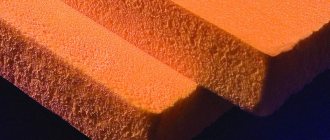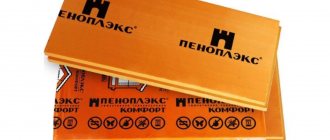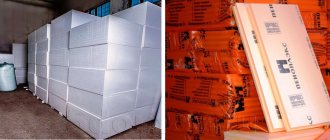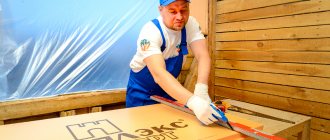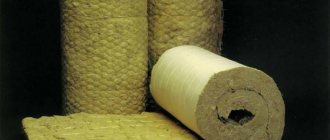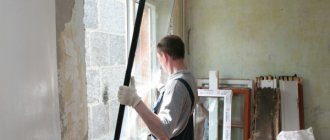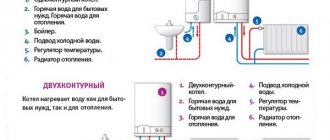Venerable rival
Insulation materials are essentially extruded polystyrene foam. This is a new generation of thermal insulators that can effectively retain heat. Today in the assortment of large stores you can find a number of such building materials that are used for similar purposes, but still differ in their characteristics. Let's look at and compare the most popular of them.
Penoplex competitors
Penoplex is one of the most popular foam materials , the properties of which have been improved as a result of additional processing - extrusion. Use of penoplex: attics, facades, roofs and foundations of buildings. For each of these objects there is a separate, most suitable type of slab.
Wide use of the product is possible due to a number of properties:
- Minimally absorbs water, which is important for heat insulators. A series of experiments were carried out, during which the product was left in water for several days - moisture penetrates only into the outer layers, and the internal closed cells remain dry.
- It has a low thermal conductivity coefficient (0.03 W*m*°C), and the value does not change significantly even in a humid environment. This expands the scope of application and allows the product to be used in conditions of increased dampness.
- Low vapor permeability – protects the surface well from moisture evaporation. Due to this property, a 2-centimeter layer of material can replace a layer of roofing felt.
- Long service life. During the experiments, it was established that the properties of the product do not change even after a significant change in external conditions - it was frozen and thawed, and also tested with water. The manufacturer indicated that the plates last about 50 years, but tests indicate a longer period of use.
- Compressive strength. Thanks to the production technology, the board has a homogeneous structure with evenly distributed small cells, which improves strength and resistance to mechanical stress.
- Easy installation. The material can be cut even with an ordinary knife. Self-installation is possible without the involvement of specialists.
- High level of environmental friendliness. The manufacturer used a type of freon that does not burn, is not poisonous and does not harm the environment.
- Minimal chemical activity. Does not react with most chemicals often used in construction: ketones (acetone, methyl ethyl ketone), formaldehyde, kerosene, gasoline, oil paints, etc.
- High biostability - the boards are not subject to rotting and decomposition.
It is also worth noting the following pros and cons of penoplex: materials of this type require maintaining a certain, not too high temperature. If this condition is violated, they will become deformed and may even ignite.
There are a number of foam-type slabs for insulation. They are made using similar technology, therefore they are similar in structure and properties, but, as a rule, they have different areas of application.
What holds the cold better: polystyrene foam or penoplex. Differences in laying technology
In the construction industry and many other areas of industry, materials such as penoplex and expanded polystyrene are in demand. What are their specifics?
What is penoplex?
Under penoplex
traditionally refers to a material obtained from polystyrene through foaming, as well as extrusion with compression. It is actively used as a thermal insulation material in the field of construction.
The structure of penoplex is represented by a large number of isolated cells that are filled with air. Their size is usually less than a millimeter. The material is characterized by great strength. The density of penoplex is about 29-35 kg / cubic meter. m, thermal conductivity is about 0.029-0.039 W/(m*K). The material has low water absorption and vapor permeability.
What is expanded polystyrene?
Under polystyrene foam
, or polystyrene foam, refers to a material that, like penoplex, is made from polystyrene by foaming, but without the use of extrusion with pressing. As a result, much larger cells are formed in the structure of the material - several millimeters in diameter.
Foam plastic can, in principle, be used for the same purposes as penoplex - as a thermal insulation material. In addition, expanded polystyrene is often used in the factory packaging of household appliances - due to its combination of lightness, softness and elasticity.
Expanded polystyrene is significantly less durable than penoplex and has higher thermal conductivity. The density of polystyrene foam is about 17-18 kg/cube. m. Its water absorption is noticeably higher than penoplex, but the vapor permeability of both materials is approximately the same level.
Comparison
The main difference between penoplex and expanded polystyrene is that the first material is produced using extrusion with pressing, as a result of which small cells are formed in its structure. Polystyrene foam is produced without using the noted technology - and therefore its cells are larger. The specifics of manufacturing materials determine the difference in their density, thermal conductivity, and water absorption.
Having determined what the difference is between penoplex and expanded polystyrene, we will reflect the conclusions in the table.
Characteristics of the technoplex
The slabs are made using similar technology and have been produced in Russia since 2006. They do not shrink, are resistant to chemical influences, but are resistant to gasoline and solvents, and are also used inside buildings. Let's compare several parameters:
| Penoplex | Technoplex | |
| Use of buildings | roofs, facades, roads | inner part |
| Density, kg/m3 | 25-47 | 26-35 |
| Flammability group | G4 | G4 |
| Water absorption,% | 0,2-0,4 | 0.2 |
| Vapor permeability | 0,012 | 0.01 |
| Price, rub/m2 | 90-250 | 100-290 |
Penoplex and polyspen comparative analysis, what are the differences
High-quality insulation is the key to indoor comfort, as well as savings on heating. Thermal insulation of buildings helps extend the service life, providing reliable protection to building materials. The modern market offers a large number of insulation materials that differ in composition, properties and cost, so it is important to choose the best option for each specific case.
What are the materials
Polyspan or penoplex are most often chosen for insulation.
Polyspan or penoplex are most often chosen for insulation. These are brands of extruded polystyrene foam. Insulation materials have excellent characteristics of thermal conductivity, moisture absorption and strength. Manufacturers use various production methods, which allows them to impart special properties to heat-insulating materials.
What is penoplex
Penoplex is a type of extruded polystyrene foam. The material has a low thermal conductivity coefficient. Foam plastic in this regard loses to penoplex. There are also differences in vapor permeability.
Polystyrene foam has a higher indicator, which prevents the formation of condensation. The low vapor permeability of penoplex has a positive and negative side.
The characteristic affects the thermal insulation qualities, and condensation may occur.
The material is flammable, but the manufacturer solves this problem by additional processing of the slabs. The key difference between insulation is strength.
Extruded polystyrene foam has a higher index, which makes it better able to withstand various types of impact, including mechanical stress.
Thermal insulation material is resistant to chemicals and does not react with ketones (acetone, methyl ethyl ketone), formaldehyde, and kerosene. There is no difference in moisture repellency between polystyrene and foam. Both materials have excellent moisture resistance.
What is polyspen
Russian-made extruded expanded polystyrene foam has good heat-insulating properties. Polyfoam slabs have the following characteristics:
- high strength;
- low thermal conductivity;
- low water absorption;
- low vapor permeability;
- environmental friendliness;
- unattractive to rodents;
- durability.
A 20 mm layer of material can replace a 40 mm thick layer of mineral wool. Even under the influence of adverse factors, polystyrene foam has a long service life.
During experiments it was found that the insulation does not lose its quality characteristics for 50 years.
Thanks to the listed properties, insulation is used for thermal insulation of floors, roofs, walls inside and outside, foundations, loggias and balconies, and road surfaces.
Comparative analysis
Penoplex and Russian-made expanded polystyrene (Polyspen) have similar properties.
At the same time, the materials are characterized by significant differences. For a good thermal insulation effect, you should carefully study the characteristics of the materials and determine the feasibility of using one or another option.
Production
The manufacturing technology of extruded polystyrene foam is similar for materials of different brands. The process involves foaming granulated polystyrene under the influence of temperature and pressure. Gases and low-boiling liquids help foam the mass.
The foam component is mixed with the polymer in an extruder. At the end of the process, molding is carried out. The mass is pressed through a die, and the insulation takes the form of slabs.
The result is a fine-mesh material, the cavities of which are filled with atmospheric air.
Scope of materials
Depending on the intended purpose, polyspen or penoplex is used. What is best should be determined based on the characteristics of each specific situation. Manufacturers produce various types of slabs that are suitable for thermal insulation of various structures and their elements.
Most often, extruded polystyrene foam is used for:
- Internal and external wall insulation. Houses are often insulated from the outside. If this is not possible, internal insulation should be considered. Carrying out outdoor thermal insulation requires prompt finishing to eliminate the negative impact of ultraviolet radiation on polystyrene foam.
- Installation of a heated floor system. It is rational to use certain types of slabs in places where floors are exposed to high loads, for example, in industrial facilities.
- Thermal insulation of the roof. The peculiarity of using penoplex or polystyrene in such a situation is that it eliminates the appearance of cold bridges. The material also forms additional protection for the waterproofing layer.
- Insulation of the foundation. When using extruded polystyrene foam, there is a significant reduction in heat loss and an extension of the service life of load-bearing structures.
- Road construction. To minimize the negative consequences of frost heaving of the soil on the highway, thermal insulation with foam or polystyrene slabs is used, which makes it possible to extend the service life of the coatings.
- Carrying out pipeline repairs. Laying new pipes with insulation makes it possible to preserve them longer and save the cost of replacement or repair work.
- Insulation of loggias and balconies. Thermal insulation of structures improves the indoor atmosphere.
For each type of thermal insulation, it is necessary to select slabs of different sizes and thicknesses. Manufacturers offer separate types of insulation specifically for roofs, foundations or walls. It is also important to study all the quality characteristics of polystyrene or penoplex in order to get the maximum from thermal insulation.
Thermal conductivity
The thermal conductivity of extruded polystyrene foam is the lowest among all insulation materials.
The coefficient remains unchanged even when humidified, which is important for maintaining a comfortable atmosphere in the room and preserving performance characteristics. For penoplex the indicator is 0.03 Wm•°C, for polystyrene – from 0.028 to 0.03 Wm•°C.
Strength
Depending on the line of insulation, the density and strength of the material varies. For polyspan, the indicator is from 35 to 45 kg/m³, for penoplex - from 20 kg/m³ and higher.
An important characteristic is considered to be compressive strength, which shows susceptibility to deformation.
Polyfoam has a compressive strength of 0.5 MPa at 10% deformation, while penoplex has a compressive strength of 0.2 MPa at the same load.
Moisture permeability and vapor permeability
Vapor permeability and water absorption are important properties for maintaining the necessary atmosphere indoors and maintaining the quality characteristics of insulation. As for vapor permeability, the coefficient for penoplex and polyspen is close to zero. The water absorption of both brands of extruded polystyrene foam is 0.3-0.4%.
Fireproof properties
Penoplex and polyspen are flammable materials. The insulation is assigned a flammability class of G3-G4 (highly and moderately flammable). When burned, toxic smoke is released that can harm human health. At the same time, manufacturers are working to improve combustion resistance. The penoplex line includes insulation with flammability class G1 (low flammability).
This was achieved thanks to additional processing and the addition of antiprenes during manufacturing. Polyspen Standard is also assigned flammability class G1. Alternative manufacturers may indicate on the packaging that the material is non-flammable (NG), but it is unrealistic to achieve such an effect. Such insulation may turn out to be a fake.
Most often, extruded polystyrene foam has self-extinguishing qualities.
Service life and processing ability
Polyfoam and penoplex are easy to install and process. The material does not crumble and is easy to cut. Manufacturers indicate a long service life. Even when exposed to negative factors, the insulation will last at least 50 years.
Price policy
In terms of cost, the materials belong to the average price category. The price of the sheet and packaging depends on the required thickness of the insulation. Penoplex costs from 80 to 330 rubles per sheet, polyspen - 67-153 rubles per sheet. For wholesale purchases, sellers offer favorable conditions.
comparison table
The main qualitative characteristics of polyspan and penoplex are described in the table.
| Properties | Polyspen | Penoplex |
| Density (kg/m³) | 30-38 | 25-47 |
| Compressive Strength(MPa) | 0,2 | 0,2 |
| Flexural strength (MPa) | 0,4 | 0,5 |
| Water absorption (%) | 0,4 | 0,5 |
| Thermal conductivity (W/m•°C) | 0,028 | 0,03 |
| Fire resistance | G1-G4 | G1-G4 |
The indicators indicated are average and may vary depending on the selected type, since individual lines of material have special properties.
When choosing which is better: penoplex or polystyrene foam, all parameters are carefully studied and insulation is selected that is most suitable for the specific case and type of thermal insulation.
Styrofoam or penoplex
A line of materials used for insulating three-layer walls, flat and pitched roofs, plinths, and underground parts of a building. Also used in the manufacture of sandwich panels, on highways and airfields.
Strength – 250-500 mPa;
Flammability group – G3 or G4;
Vapor permeability – 0.006 mg/(mh*Pa).
What is the difference between polystyrene foam and penoplex?
Their basis is the same similar composition, processed under different conditions, which determines the final indicators of overall strength, moisture absorption and cost.
Of course, penoplex has greater bending strength, therefore, under conditions of a similar mechanical load, the foam can break into separate pieces. Under such conditions, dents or cracks may appear on the surface of the penoplex, but there is no strong crushing into individual granules. A feature of penoplex is the almost complete absence of air and moisture permeability, and polystyrene, at the same time, is characterized by fairly high water absorption rates.
Both materials deservedly belong to the category of combustible finishing insulation, but treatment with special fire retardants can significantly reduce such indicators. It is also important to consider that penoplex, unlike traditional polystyrene, melts in a fire, but does not burn.
When insulating the facades of buildings, both popular types of polystyrene foam can be used, which do not have significant differences in installation, but, as a rule, differ significantly in cost.
For information on how to cover a stove with tiles in winter, with detailed instructions, read the link.
Find out more about a homemade garage heater here.
Penoplex and expanded polystyrene: choosing the best insulation
If the insulation absorbs water, then over time its thermal insulation qualities will inevitably decrease. Extruded polystyrene foam differs from other heat-insulating materials in its minimal moisture absorption, high strength, durability and monolithic structure.
PENOPLEX is extruded polystyrene foam, the production of which is established at factories located in many cities in Russia and abroad. The most modern equipment from the world's leading manufacturers allows us to guarantee the highest quality of products under the PENOPLEX brand.
PENOPLEX insulation is chemically inert (does not emit harmful chemical compounds when used within the permissible temperature range (from -50 ° C to +75 ° C), is not subject to rotting and biodegradation. You can work with it in any weather conditions without any means protection from atmospheric precipitation.The slabs are easy to process (can be cut well using a regular knife) and are extremely simple to install.
The durability of the thermal insulation material is confirmed by NIISF protocol No. 132-1 dated October 29, 2001 (Russian Academy of Architecture and Construction Sciences) and is more than 50 years.
PENOPLEX COMFORT - specially designed for low-rise construction. The balance of technical characteristics of the universal material PENOPLEX K0MF0RT, such as: strength, zero water absorption, high thermal protection, biostability and environmental friendliness, allow it to be used effectively in all structures without overpaying for the enhanced properties of professional brands.
PENOPLEX WALL - optimal for insulating external and internal vertical enclosing structures (walls, partitions, facade systems); minimal water absorption, absolute biostability, low thermal conductivity (1.4 times more effective than mineral wool, and 1.3 times more effective than ball foam) provide reliable protection for your facade throughout its entire service life. The flammability group of PENOPLEX WALL is reduced, and the presence of special fire retardant additives makes it possible to prevent spontaneous combustion.
PENOPLEX ROOF - optimal for insulating roofs of any type; The compressive strength of this type is 25 t/m2. The flammability group of PENOPLEX ROOF is reduced, and the presence of special fire retardant additives makes it possible to prevent spontaneous combustion.
Comparing technoplex and penoplex
In fact, the composition of technoplex and penoplex is much more complex; it includes stabilizers, fire retardants, antioxidants and substances that slow down secondary polymerization. The difference may be in temperature, pressure and the use of gas-forming agent.
What is the difference between foamed polystyrenes?
What is the difference? The powder or liquid gas-forming agent can be better mixed and distributed throughout the volume of polystyrene granules, so such insulation materials have more stable thermal insulation characteristics.
But this is not the only reason why the modern production of technoplex and penoplex refuses to use freon:
- In the sealed cells of new, unused material, freon gas remains for some time, which is formally considered safe, but in practice it is better to get rid of it, since it often leads to lung problems, especially in children;
- Over time, the gas is replaced by air and water vapor. If not the purest raw materials with styrene residues were used for the production of expanded polystyrene, then gradually part of the contents of the technoplex cells will be squeezed out into the environment.
Comparative analysis
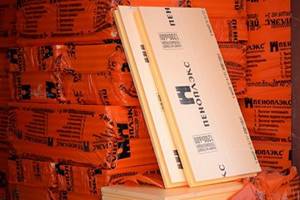
Despite the fact that in both cases the basis for production is polystyrene, the production technology has some significant differences.
Let's consider each of these types from the point of view of its structure and composition:
- The structure of the foam is gas-filled granules and micropores, which is due to the active foaming of the base. Density indicators directly depend on the size of the voids that unite the compressed granules. The dimensions of such voids are inversely proportional to the density level of the resulting material, and are also reflected in the vapor-permeable and moisture-absorbing characteristics;
- Penoplex production is based on the extrusion method, in which closed pores measuring 0.2 mm or less are formed under conditions of high pressure and high temperature. The result is a material that has a very uniform structure.
The main difference between such materials is the different scope of application, due to the difference in the main characteristics:
| Index | Styrofoam | Penoplex |
| Thermal conductivity | 0.04 W/mK | 0.032 W/mK |
| Moisture permeability | 2% | 0,4% |
| Compressive strength | 0.2 MPa | 0.5 MPa |
| Density | 15-35kg/m 3 | 28-45kg/m 3 |
Production technology and basic characteristics necessarily affect the average cost of the finished material.
Specifications
The material “Polyspen” , average density 35 kg/m³ , is made in slabs 600 mm wide and 1200 mm long with quarter processing around the perimeter. By agreement with customers, slabs of various lengths can be produced, both with straight and stepped edges. The technical equipment of the enterprise allows us to produce slabs with a rough surface of two types (fine and deep “notch”), which is very suitable for insulating walls using the “wet” facade method. The thickness of the slabs is from 20 to 80 mm. Polyspen boards are packaged in polyethylene film with protection from the penetration of UV rays. Package height 40-42 with the number of plates from 4 to 17 pcs. The volume of one package of slabs (standard) is 0.288 m3. The slabs can be stored outdoors in their original packaging. When stored without packaging, they must be protected from prolonged exposure to sunlight to prevent destruction of the top layer.
Extruded polystyrene foam
Penoplex is a tile insulation made from extruded polystyrene foam. Unique thermal insulation characteristics are achieved thanks to the smallest cells filled with air.
Penoplex has a bright and recognizable orange color. Penoplex has excellent chemical resistance, but it is important to know that it is absolutely not resistant to gasoline (just like Technoplex). Due to its good strength properties, Penoplex can be used for external insulation.
There are different types in the Penoplex line (their names speak for themselves):
- roofing (insulation of attics and roofs of various configurations);
- wall (basement, walls, partitions, facade are insulated);
- foundation (used as insulation for the basement and floor of the first floor);
- comfort (can be used for any work, but is especially well suited for insulating apartments and balconies);
- 45 (has the best characteristics of all types, used in road construction and bridge construction).
. Penoplex is available in standard width and length - 600 mm by 1200 mm, respectively. But the thickness varies - from 20 mm to 150 mm.
Penoplex is used at temperatures from -50 0 C to +75 0 C. Water absorption - 0.4% - slightly worse than Technoplex, but still a very high figure. Thermal conductivity is 0.03 W/(m*K).
This material will help you find out which polystyrene foam or polyurethane foam is better:
Water absorption and thermal conductivity
If you are faced with the question of what is better - penoplex or technoplex, then it is important to pay special attention to the ability of water absorption and thermal conductivity. The first material is capable of conducting heat, depending on the type and external conditions under which operation occurs. This indicator varies from 0.028 to 0.031 W/mK.
The opponent has a thermal conductivity within 0.031 W/mK. This indicates that both materials are effective insulators. The water absorption of the technoplex is also important; it does not exceed 0.2% by volume during the day. Whereas, if we consider type 35 penoplex, water absorption is 0.1%. If this material is immersed in water for 28 days, it will expand by only 0.2% of its volume. Among other things, this thermal insulator retains its original properties after an impressive number of freezing and thawing cycles. After 1000 cycles, penoplex will change the thermal resistance by only 5%.
General comparative characteristics
If you still can’t decide whether technoplex or penoplex is better, you should definitely read reviews about these materials before purchasing. However, it is equally important to familiarize yourself with the main technical characteristics. For example, experts advise paying attention to the area of use.
Penoplex is intended for internal, external and roofing thermal insulation; this material is also excellent for road work. Technoplex, in turn, is used for work on internal insulation of residential premises. Graphite acts as additional additives for the first mentioned material, while for the second insulation their role is played by fire retardant additives, which applies to all series used for thermal insulation of walls. The density of the material is approximately the same, for example, for penoplex this indicator varies from 25 to 47 kilograms per cubic meter, while for the opponent it is from 26 to 35 kg per cubic meter.
If you have not decided whether technoplex or penoplex is better, it is recommended to read the reviews in advance; they echo the characteristics presented in the article. Many consumers pay attention to how flammable the material is. Both materials belong to class G4, which indicates a lack of resistance to direct fire.
The house should not only be beautiful and comfortable, but also warm. Therefore, it is very important to choose the right insulation.
There are many different insulation materials on the construction market. This article will tell you about such modern insulation materials as Technoplex and Penoplex, how they differ and which one is better to choose.
Let's start with what they consist of. Both insulation is made of extruded polystyrene foam (EPS). EPS is heated polystyrene (the familiar white foam balls) and a foaming agent.
